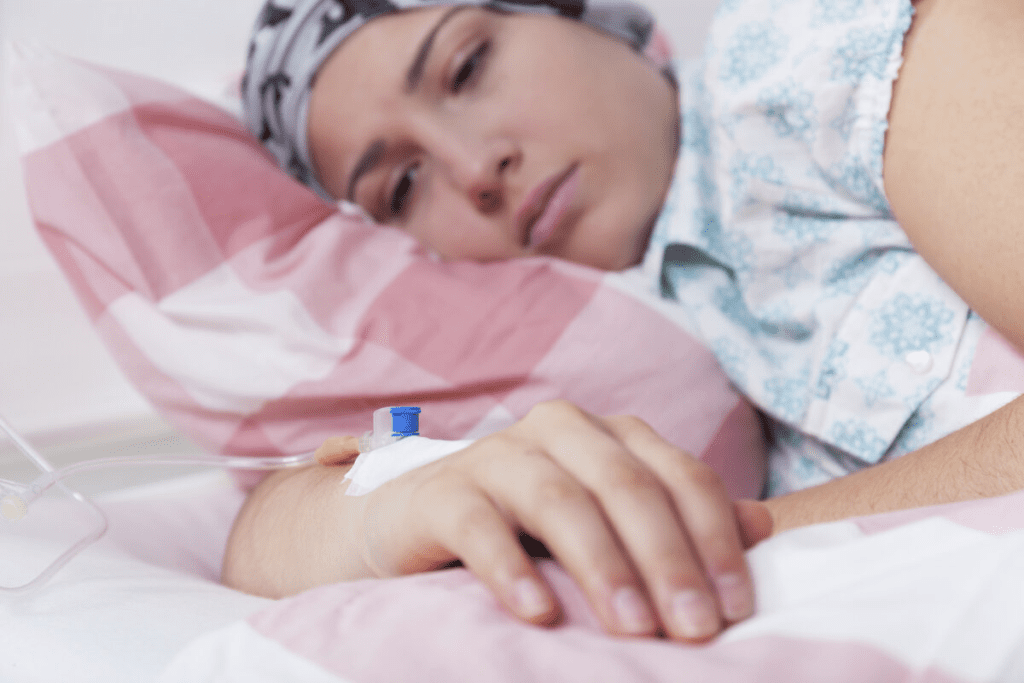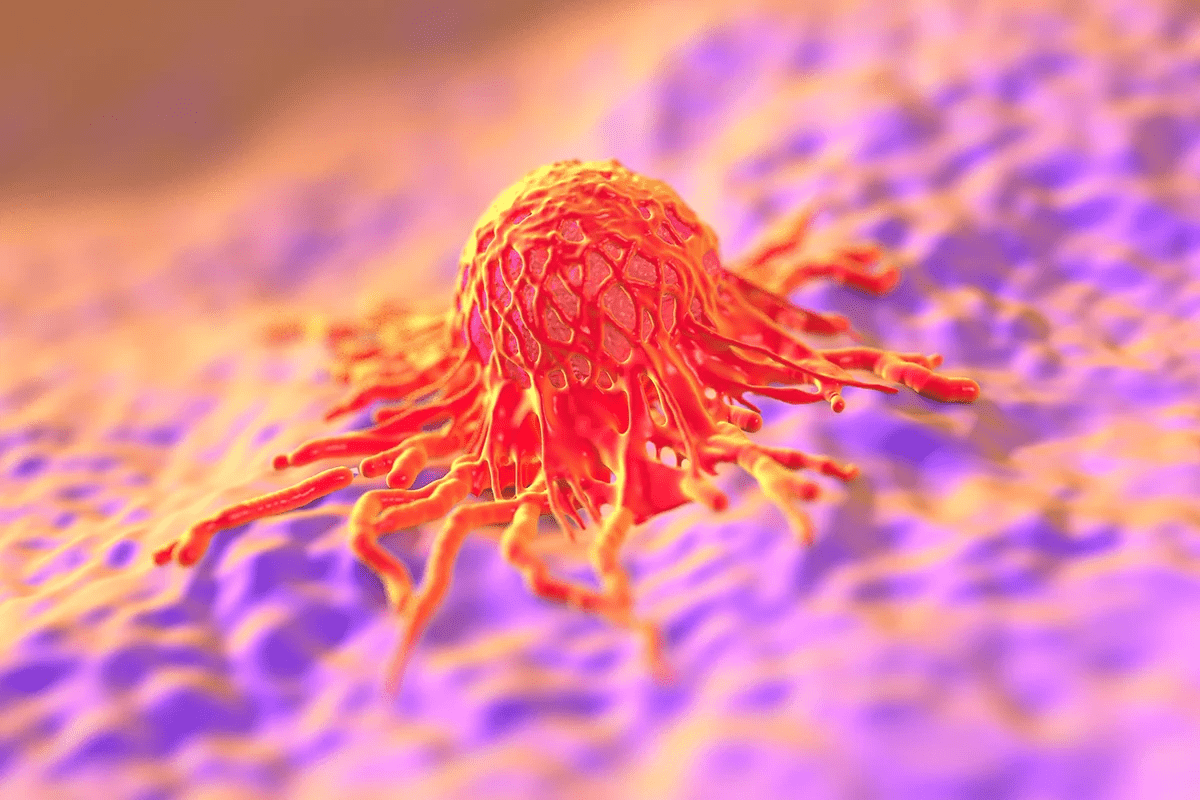Last Updated on November 26, 2025 by Bilal Hasdemir

Adjuvant chemotherapy is a common treatment for many cancers. It can cause hair loss, a distressing side effect for many. Up to 65% of patients experience hair loss during chemotherapy.Does radiation therapy make you lose your hair? Find out how it compares to chemo and what to expect. lets check it out now.
Hair loss, or alopecia, is a big worry for those starting adjuvant chemotherapy. The amount of hair lost varies. It depends on the chemotherapy drugs, dosage, and the patient’s health.
Knowing what to expect can help patients prepare for hair loss. Adjuvant chemotherapy hair loss is usually temporary. But, it can be very hard emotionally.
Key Takeaways
- Chemotherapy-induced hair loss affects a significant percentage of patients.
- The extent of hair loss depends on the chemotherapy regimen and individual factors.
- Hair loss is often temporary but can be emotionally distressing.
- Understanding the potential for hair loss can help patients prepare.
- Discussing concerns with a healthcare provider can provide additional support.
Understanding Adjuvant Chemotherapy and Hair Loss
It’s important for patients to know about adjuvant chemotherapy before making treatment choices. This treatment is given after the main therapy to lower cancer return risk.
What is adjuvant chemotherapy?
Adjuvant chemotherapy aims to kill any cancer cells left after main treatments like surgery or radiation. It helps lower the chance of cancer coming back.
How adjuvant chemotherapy affects hair follicles
Adjuvant chemotherapy targets fast-growing cells, including hair follicles. This can cause hair loss because it disrupts hair growth.
Differences between adjuvant and neoadjuvant treatments
Adjuvant and neoadjuvant chemotherapy differ in when they are given. Neoadjuvant is before the main treatment to shrink tumors. Adjuvant is after to kill any remaining cancer cells.
| Treatment Type | Timing | Purpose |
| Neoadjuvant Chemotherapy | Before primary treatment | Shrink tumors |
| Adjuvant Chemotherapy | After primary treatment | Eliminate remaining cancer cells |
Knowing about adjuvant chemotherapy and its side effects, like hair loss, helps patients prepare for treatment.
The Science Behind Chemotherapy-Induced Hair Loss
Chemotherapy works by targeting rapidly dividing cells. This includes hair follicles. The drugs aim to kill cancer cells that grow fast. But they also harm other fast-growing cells, like those in hair follicles.
How Chemotherapy Targets Rapidly Dividing Cells
Chemotherapy attacks cells that are dividing. Hair follicle cells grow very fast. So, they are very sensitive to chemotherapy.
Why Hair Follicles Are Vulnerable to Chemotherapy
Hair follicles are hit hard by chemotherapy. They grow fast, making them vulnerable. This leads to hair loss.
Cellular Mechanisms of Hair Follicle Damage
Hair follicle damage comes from cell death. Hair matrix cells, key to hair growth, die. This stops hair from growing, causing hair loss.
Does Radiation Therapy Make You Lose Your Hair?

Many cancer patients worry about hair loss during radiation therapy. Chemotherapy is known for causing hair loss, but radiation therapy can also affect hair. The extent and type of hair loss vary.
Radiation Therapy vs. Chemotherapy Hair Loss
Radiation therapy and chemotherapy are treatments for cancer, but they work differently. Chemotherapy affects hair follicles all over the body, leading to widespread hair loss. Radiation therapy, on the other hand, targets specific areas. It usually causes hair loss only in the treated area.
Factors Determining Radiation-Induced Hair Loss
Several factors influence hair loss from radiation therapy. These include the radiation dose, where the treatment is given, and the patient’s health. Higher doses of radiation increase the risk of hair loss.
Treatment Field Location and Hair Loss Correlation
The location of the radiation treatment field is key in determining hair loss. For example, radiation to the head or scalp is more likely to cause hair loss. Knowing the treatment area helps patients prepare for possible hair loss.
It’s important for patients to talk to their healthcare provider about hair loss risks before starting radiation therapy. Understanding the side effects helps patients prepare for the treatment and its effects.
Types of Hair Loss During Cancer Treatment

Hair loss is a common side effect of cancer treatment. It comes in several forms. Knowing these can help patients get ready for how their hair might change.
Complete Hair Loss (Alopecia)
Complete hair loss, or alopecia, is a big worry for cancer patients. It means losing hair all over the scalp. This usually happens because of chemotherapy or radiation therapy aimed at the head. Alopecia can be emotionally challenging, affecting how patients feel about themselves.
Partial Thinning
Not everyone loses all their hair. Some might just see their hair thin out. This can happen if the chemotherapy dose is lower or if the treatment doesn’t target the scalp. Partial thinning can be upsetting, changing how hair looks.
Body Hair Loss
Cancer treatment doesn’t just affect scalp hair. It can also lead to losing hair on the arms, legs, and underarms. Losing body hair might not be as obvious as losing hair on the head. But it can make patients feel like they’re losing more hair.
Eyelash and Eyebrow Loss
Cancer treatment can also cause eyelash and eyebrow loss. Losing these hairs can be tough, as they help with facial expressions and protecting the eyes. Patients might need to find ways to protect their eyes or use makeup.
Knowing about the different types of hair loss during cancer treatment helps patients and their caregivers prepare. The physical changes are big, but the emotional impact is just as important.
Timeline of Hair Loss with Adjuvant Chemotherapy
Knowing when hair loss happens during adjuvant chemotherapy helps patients get ready for it. Hair loss, or alopecia, is a common side effect of cancer treatment. It affects not just the scalp but also other body parts.
When Hair Loss Typically Begins
Hair loss often starts a few weeks after starting adjuvant chemotherapy. The exact start time can change based on the chemotherapy drugs, dosage, and the patient’s health.
Progression of Hair Thinning to Loss
Hair thinning quickly turns into significant hair loss, usually in just a couple of weeks. This fast change can be very upsetting for patients. It shows how important it is to be prepared and have support.
Individual Variations in Hair Loss Timing
The timing and amount of hair loss can differ a lot among people getting adjuvant chemotherapy. Things like the chemotherapy type, patient health, and genetics can affect how much and when hair loss happens.
Understanding these factors and the typical timeline of hair loss helps patients deal with the changes during adjuvant chemotherapy.
Common Chemotherapy Drugs and Their Hair Loss Effects
The type of chemotherapy drug used can greatly affect how much hair loss patients experience. Adjuvant chemotherapy is given after primary treatment to lower cancer recurrence risk. It includes drugs with varying hair loss effects.
High-risk medications for hair loss
Some chemotherapy drugs are more likely to cause hair loss. Anthracyclines, like doxorubicin, and taxanes, such as paclitaxel, are examples. These drugs target fast-growing cells, including hair follicles, leading to significant hair loss.
Lower-risk options
Other chemotherapy drugs are less likely to cause hair loss. For instance, 5-fluorouracil and cyclophosphamide may lead to less hair loss. But, the amount of hair loss can vary based on the drug dose and combination.
Combination therapy effects
Using chemotherapy drugs together can increase hair loss risk. While combination therapy is more effective against cancer, it exposes patients to more drugs affecting hair follicles. This can result in more severe hair loss.
Dose-dependent hair loss
The dose of chemotherapy drugs also plays a big role in hair loss. Higher doses increase hair loss risk. Dose-dense regimens, with higher doses at shorter intervals, can worsen this effect.
Knowing how different chemotherapy drugs affect hair loss helps patients and doctors make better treatment choices. It also helps find ways to manage hair loss.
Radiation Therapy and Localized Hair Loss
Radiation therapy is a key part of cancer treatment. It can cause hair loss in areas exposed to radiation. This is a big worry for many patients getting treatment.
Treatment Areas and Corresponding Hair Loss
The amount and where hair loss happens depends on the treatment area. For example, radiation to the head can cause hair loss on the scalp. Radiation to other parts of the body can lead to hair loss in those areas.
Common areas affected include:
- The scalp, when the head or neck is treated
- The chest or back, in cases of breast or thoracic radiation
- The pubic area, during pelvic radiation
Permanence of Radiation-Induced Hair Loss
Whether hair loss from radiation therapy is permanent or temporary varies. Sometimes, hair may grow back after treatment. Other times, the loss may be permanent, mainly with higher doses of radiation.
The factors influencing permanence include:
- The dose of radiation received
- The area of the body treated
- Individual patient factors
Radiation Dosage and Hair Follicle Damage
The amount of radiation is key in how much hair follicle damage happens. Higher doses are more likely to cause lasting hair loss.
Radiation dosage effects:
- Lower doses may result in temporary hair thinning
- Higher doses can lead to more severe and potentially permanent hair loss
Temporary vs. Permanent Hair Loss in Cancer Treatment
It’s important for cancer patients to know the difference between temporary and permanent hair loss. Hair loss, or alopecia, is a tough side effect of cancer therapy. It can hurt patients’ self-esteem and how they see their bodies.
Distinguishing Between Temporary and Permanent Loss
Temporary hair loss is common with some cancer treatments, like chemotherapy. Often, hair grows back after treatment ends. But, some treatments can cause permanent hair loss.
Risk Factors for Permanent Hair Loss
Several things can make permanent hair loss more likely. These include the type and dose of chemotherapy, radiation therapy to the head or neck, and individual patient factors.
| Factor | Temporary Hair Loss | Permanent Hair Loss |
| Chemotherapy Type | Often with certain chemotherapy regimens | More common with high-dose or certain types of chemotherapy |
| Radiation Therapy | Less likely if radiation is not targeted at the head or neck | More likely with high doses of radiation to the scalp |
Long-term Follow-up Studies
Long-term studies are key to understanding hair loss. They show that while many patients see their hair grow back, some may face lasting or permanent hair loss.
Preventing Hair Loss During Cancer Treatment
Hair loss during cancer treatment is a worry for many. But, there are ways to prevent or lessen it. Alopecia, or hair loss, is a common side effect of cancer therapy. It affects patients’ emotions and mental health.
Scalp Cooling Systems and Their Effectiveness
Scalp cooling systems are a new hope for preventing hair loss. They cool the scalp before, during, and after chemo. This reduces blood flow and lessens chemotherapy’s impact on hair follicles.
Effectiveness: Research shows scalp cooling can help reduce hair loss for some chemo types.
- Reduces chemotherapy delivery to the scalp
- Can be used for various chemotherapy regimens
- May not be suitable for all types of cancer treatment
Minoxidil and Other Medications
Minoxidil is another option for preventing hair loss. It was first used for high blood pressure but also promotes hair growth.
Benefits: Minoxidil can be applied to the scalp to possibly reduce hair loss.
- Easy to apply
- Available over-the-counter
- May have varying effectiveness
Emerging Treatments and Clinical Trials
New treatments are being studied to prevent hair loss during cancer treatment. These include medications and devices to protect hair follicles.
Clinical trials are ongoing to check if these treatments are safe and work well.
Insurance Coverage for Prevention Methods
Insurance coverage for hair loss prevention varies. Some plans cover scalp cooling systems or other methods, while others don’t.
Action: Patients should talk to their insurance to see what’s covered.
Exploring these options helps patients make informed choices. They can lessen the impact of hair loss during cancer treatment.
Hair Regrowth After Radiation Therapy
It’s important for patients to know about hair regrowth after radiation therapy. This treatment can affect hair growth. The impact depends on several things, like the area treated and the dose of radiation.
Factors Affecting Regrowth
Many things can affect hair regrowth after radiation therapy. These include the radiation dose and the area treated. A patient’s overall health also plays a role.
Higher doses of radiation can harm hair follicles more. This can make regrowth less likely. The area treated also matters. For example, scalp radiation can cause hair loss on the head.
Managing Expectations
It’s key for patients to have realistic expectations about hair regrowth. Regrowth may not happen right away. It can take time, and the quality of the new hair may be different.
Doctors can help by explaining what to expect based on the treatment plan. They can also talk about ways to support hair growth.
Differences in Regrowth Patterns by Treatment Area
Hair regrowth patterns can vary by treatment area. For example, scalp hair may grow back differently than eyebrows or body hair.
Knowing these differences helps set realistic expectations. Some areas might not grow hair back at all, depending on the radiation damage.
Timeline for Radiation-Related Hair Regrowth
The time it takes for hair to regrow after radiation therapy varies. It usually starts several months after treatment ends.
The process can be slow, taking up to a year or more for noticeable growth. In some cases, hair may not grow back, depending on the radiation dose.
Supporting Hair Regrowth Post-Treatment
Recovering from cancer treatment means focusing on many areas. This includes eating right, taking care of your hair gently, and treating your scalp.
Nutritional Support for Healthy Hair
Eating foods rich in vitamins and minerals is key for hair to grow back. Foods like protein, iron, and biotin are great for hair health. Salmon, spinach, and almonds are good choices.
Gentle Hair Care Products
Choosing gentle hair care products is important. Look for shampoos and conditioners without sulfates. They’re made for damaged hair. Regular conditioning treatments also help hair follicles.
Scalp Treatments and Massages
Scalp massages boost blood flow to hair follicles, helping them grow. Use gentle scalp massagers or your hands. Scalp treatments with essential oils like rosemary or peppermint also help.
Supplements and Their Evidence Base
Supplements like biotin, vitamin D, and fish oil might help hair grow. But, talk to a doctor before taking them. Research shows some supplements can help hair grow.
| Nutrient | Benefit for Hair Regrowth | Food Sources |
| Protein | Builds hair structure | Chicken, Fish, Eggs |
| Iron | Promotes hair growth | Red Meat, Spinach, Beans |
| Biotin | Strengthens hair follicles | Nuts, Eggs, Whole Grains |
Conclusion
It’s important for cancer patients to know how adjuvant chemotherapy and radiation therapy affect hair loss. Adjuvant chemotherapy can lead to a lot of hair loss. This happens because it affects cells that grow fast, like hair follicles.
Radiation therapy also causes hair loss, mainly when it’s used on the head or scalp. How much hair is lost depends on where the treatment is applied, the dose, and personal factors.
To deal with hair loss during treatment, patients can try scalp cooling systems and take good care of their hair after treatment. Eating right and using gentle hair products can help. Hair can grow back, but it takes time and varies for everyone.
In summary, while chemotherapy and radiation can lead to hair loss, there are ways to lessen its impact. Knowing about hair loss can help patients handle this tough part of their treatment better.
FAQ
Does adjuvant chemotherapy always cause hair loss?
No, not all adjuvant chemotherapy treatments cause hair loss. The likelihood of hair loss depends on the type of chemotherapy drugs used, the dosage, and individual patient factors.
How does radiation therapy cause hair loss?
Radiation therapy damages the hair follicles in the treatment area. The severity of hair loss depends on the radiation dose and the location of the treatment field.
Can hair loss from adjuvant chemotherapy be prevented?
Yes, there are ways to prevent or minimize hair loss during adjuvant chemotherapy. Methods include scalp cooling systems and medications like minoxidil. The effectiveness varies by individual and chemotherapy type.
Is hair loss from radiation therapy permanent?
Hair loss from radiation therapy can be permanent. It depends on the radiation dose and the treatment area. Higher doses are more likely to cause permanent hair loss.
How long does it take for hair to regrow after radiation therapy?
Hair regrowth after radiation therapy varies. It can take several months to a few years. In some cases, hair may not regrow at all.
Are there any treatments to support hair regrowth after cancer treatment?
Yes, several treatments can support hair regrowth. These include nutritional supplements, gentle hair care products, scalp treatments, and massages. The effectiveness varies by person.
Can chemotherapy drugs used in adjuvant chemotherapy cause different levels of hair loss?
Yes, different chemotherapy drugs have varying potentials for causing hair loss. Some drugs are more likely to cause significant hair loss, while others may result in minimal or no hair loss.
How does the location of the radiation treatment field affect hair loss?
The location of the radiation treatment field directly affects hair loss. Radiation to areas with hair, such as the head or neck, can cause hair loss in those specific areas.
Are there any new or emerging treatments to prevent hair loss during cancer treatment?
Yes, there are emerging treatments and clinical trials for preventing hair loss during cancer treatment. These include advanced scalp cooling systems and other pharmacological interventions.
Does insurance cover methods to prevent hair loss during cancer treatment?
Insurance coverage for hair loss prevention methods varies. Some insurance plans may cover treatments like scalp cooling systems, while others may not. It’s essential to check with your insurance provider.
References
- Trueb, R. M. (2009). Chemotherapy-induced alopecia. Seminars in Cutaneous Medicine and Surgery, 28(1), 11“14. https://pubmed.ncbi.nlm.nih.gov/19254610/






